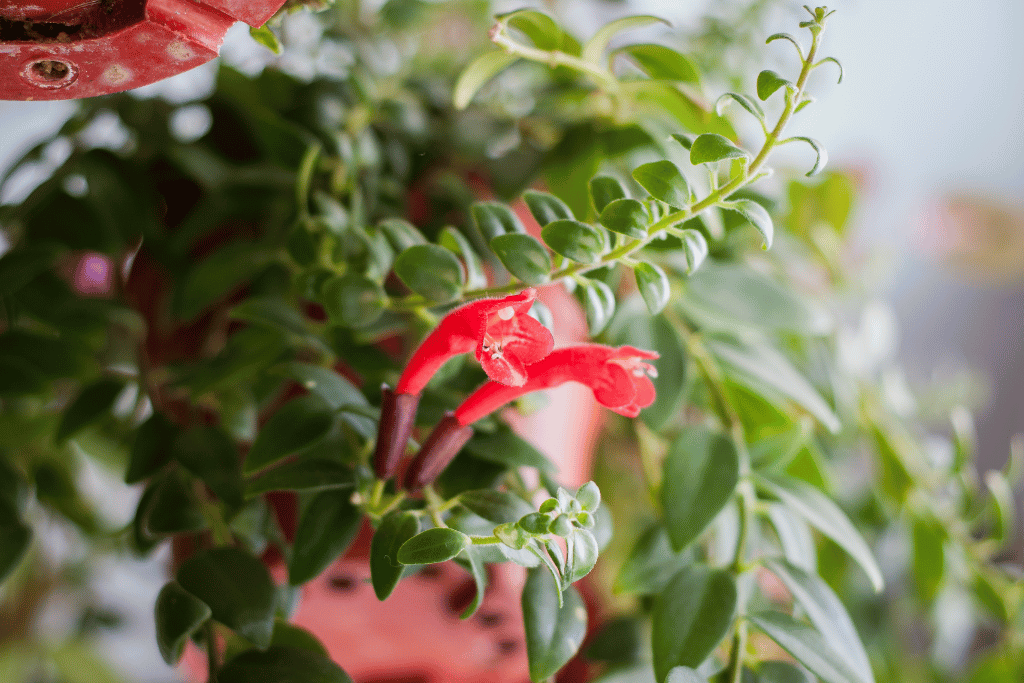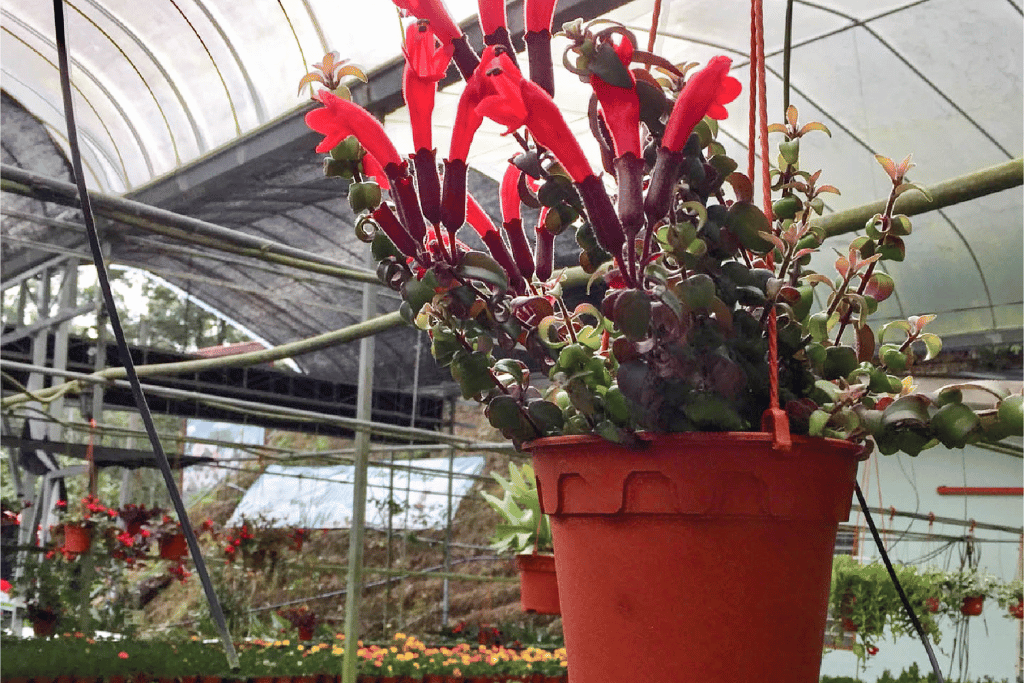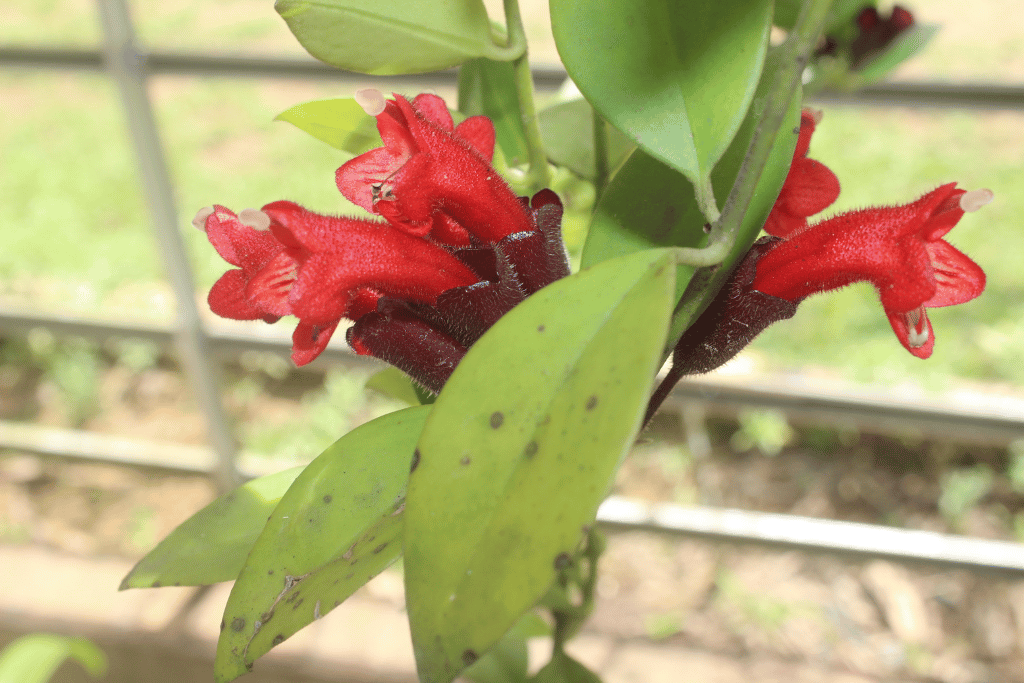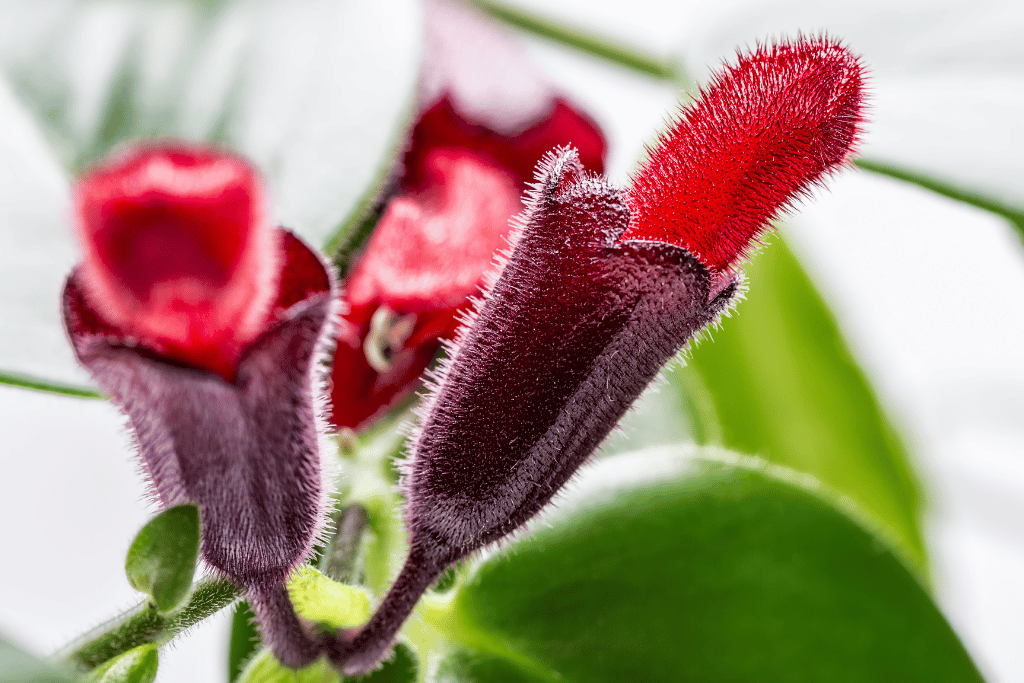
The Black pagoda lipstick plant! What an intriguing name. No, it’s not a makeup product gone rogue in the garden, but a striking vine that will make your garden truly stand out.
As someone who’s grown this exotic beauty before, let me tell you, it’s a plant that demands attention. With its dark, glossy foliage and its stunning red blooms that resemble little tubes of lipstick, it’s impossible not to be smitten.
I remember when I first got my hands on this unusual plant and I was surprised by how easy it was to take care of. After a few weeks of consistent watering, sunlight exposure, and the occasional pruning session, I could already see it flourishing in my garden!
Are you invested enough to try it out too? I’ll let you in on my secrets of Black pagoda lipstick plant care, flowering tips, propagation and more. All you need to do is stay with me throughout this guide.
Before we move to the actual growing and caring guidelines, let’s talk about what makes this plant so special and why you should grow it in your garden.
What Makes the Black Pagoda Lipstick Plant Special?
My garden is full of various plants, yet the Black pagoda lipstick plant stands out as my favorite. Its stunning, dark foliage and enchanting blooms in a deep red shade are truly captivating!
Origin:
This plant is native to the southeast Asia rainforests where it grows as an epiphyte. It is a tropical plant and needs to be kept warm and consistently damp.
Appearance:
When I first set my eyes on this plant, it was love at first sight. Its dark and glossy leaves were simply mesmerizing; they almost looked black! And when the vibrant tube-shaped flowers bloomed in shades of red all year round? Oh boy, that did me in. It’s a touch of glam to your garden – who could say no to that? Needless to say, I had to take it home with me right away!
Size:
With the ability to reach a staggering height of three feet, the Black pagoda lipstick plant is an ideal choice for those looking to add something special and full of life to their garden. Because it doesn’t require much room, this fast-growing plant is perfect in a hanging basket or on a trellis – any structure that can support its growth will do!
Maintenance:
This plant requires less maintenance. It likes bright, indirect light and doesn’t need much water. You only need to water it when the top inch of soil is dry. It’s like having a plant that tells you when it’s thirsty. It’s also very forgiving if you forget to water it, which is great news for forgetful gardeners like myself.
Fun fact:
The Black pagoda lipstick plant is part of the Gesneriad family, which also includes the African violet. But let’s be real, the Black pagoda lipstick plant is way cooler than its violet cousin. It’s like the rockstar of the family, and it’ll make your garden look like a concert.
Now that you know what makes this plant so great, let’s move on to growing and caring for it.
Growing a Black Pagoda Lipstick Plant

Growing a Black pagoda lipstick plant is not only easy, but it’s also a lot of fun. I’ve had this plant in my garden for a while now, and it has quickly become one of my favorites. In this step-by-step guide, I’ll walk you through everything you need to know to grow a Black pagoda lipstick plant, including different ways to grow it, care tips, and some fun facts.
Step 1: Choose your growing method
You have two options for growing a Black pagoda lipstick plant: potting it or growing it as an epiphyte. Growing in a container is simple and can be done both indoor and outdoor, while developing your plant as an epiphyte needs more effort on your part.
Growing in a pot: To grow in a pot, you’ll need a pot that is at least 5 inches in diameter, some good quality potting soil, and a trellis or stake to support the plant. Fill your pot with fresh, nutrient-rich potting soil and plant the Black pagoda lipstick plant in its center. Don’t forget to water it well before positioning it near a bright yet indirect light source – this will ensure that your new plant thrives!
Growing as an epiphyte: To cultivate epiphytes, it’s essential to secure them on either a piece of wood or moss pole with the aid of fishing line or wire. Moreover, keep tabs on retaining the moisture in the moss and spray your plant frequently in order to simulate rainforest humidity levels which they have evolved with.
As for the methods, the preferable way is to go with black pagoda lipstick plant propagation. However, you can try the seed germination or hydroponic method too. We’ll discuss these methods in a while.
Read more deeply: How to start seeds for hydroponics?
Step 2: Provide the right environment
To ensure your Black pagoda lipstick plant is healthy and thriving, give it plenty of indirect light. Direct sunlight can be too intense for the plant which could cause foliage discoloration or wilting; if you notice leaves turning yellow or brown, this may indicate that there’s too much sun exposure. With just the right amount of bright lighting, your lipstick plant will remain vibrant!
The Black pagoda plant is optimally kept in a warm atmosphere, ranging from 70-85°F. Despite this, it can withstand temperatures as low as 60°F if necessary.
Step 3: Watering
This plant is truly a hassle-free houseplant! It only needs to be watered when the top inch of soil is dry – usually just once every week or two depending on your climate. Just remember: too much water will lead to root rot, so don’t overdo it!
Step 4: Feeding
When it comes to nourishment, it doesn’t require much fertilizer. Using a balanced water-soluble fertilizer once every month during spring and summer should suffice. Make sure you follow the instructions on your chosen fertilizer packaging as excessive fertilization could lead to more harm than good for this plant!
Step 5: Pruning
Pruning the Black pagoda lipstick plant is not a necessity, but it can promote bushier growth and stave off lankiness. In early spring before new shoots emerge, cut back around one-third of its size using clean and sharp pruning shears to avoid causing any harm to the plant.
Step 6: Repotting
This plant prefers living a bit root-bound and doesn’t need to be replanted too often. Every two or three years, or when the roots start to come out of the drainage holes in its pot, go ahead and repot it with one that is slightly larger than its current container. Keep in mind that this particular plant likes feeling snug!
3 Methods to Grow a Black Pagoda Lipstick Plant

The three ways to grow a black pagoda lipstick plant are:
- Propagation (recommended).
- From seed.
- Hydroponically.
Method#1 – How to Propagate a Black Pagoda Lipstick Plant?
Propagating my black pagoda lipstick plant was quite the experience! I’ve always been a fan of propagating plants, and this time I decided to try out the water propagation method. And it works like a charm! The process is super easy. Here’s how I carried out my black pagoda lipstick plant propagation in water:
1. Take a healthy stem:
First, I carefully selected a healthy stem from my existing plant. I wanted to make sure it had at least two nodes and a few leaves on it, so that it had a good chance of growing roots. Once I had the perfect stem, I snipped it using a sharp, clean pair of scissors. To increase the surface area for water absorption, I made the cut at a 45-degree angle.
2. Remove the lower leaves:
In the next step, I removed the lower leaves from the stem, leaving only a few at the top. This step is important because it prevents the leaves from sitting in the water, which could cause them to rot. Trust me, you don’t want that to happen!
3. Place the stem in a water-filled jar:
I then filled a small glass jar with water and placed the stem in it. I made sure that the bottom of the stem was fully submerged in the water, but not touching the bottom of the jar. This is important because you don’t want the stem to sit in stagnant water, which can cause the roots to rot.
4. Move the jar in a sunny spot:
I placed the jar in a spot with bright, indirect light and changed the water every few days. This step is crucial for the success of water propagation, as it helps to keep the water fresh and oxygenated. I also made sure to keep an eye on the water level and add more if necessary.
5. Wait for root formation:
After about two weeks, I noticed roots beginning to form on the stem! It was such an exciting moment for me, watching my propagation experiment work. I may have done a little happy dance around the house (I don’t remember to be honest)!
6. Transplant:
Once the roots were about an inch long, I carefully transplanted the stem into a small pot with fresh, well-draining potting soil. I made sure to water it thoroughly and placed it in a spot with bright, indirect light.
And voila! It’s done. Give it a try yourself and see how it goes for you! Just don’t forget to change the water and keep an eye on those roots.
Method#2 – How to Grow a Black Pagoda Lipstick Plant From Seed?
Here’s a step-by-step guide on how to grow a black pagoda lipstick plant from seed:
Step 1:
Get some fresh black pagoda lipstick plant seeds for the best chance of germination. You can easily find them at a nursery or pick them yourself from an existing plant. Ensure they’re not expired – we don’t want any issues with germination!
Step 2:
In order to properly plant the seeds, you’ll need a suitable container. To ensure successful planting, I’ll recommend selecting a pot that is approximately 4 inches in diameter with holes at the bottom for drainage purposes.
Step 3:
Ensure your chosen container is filled with a superior quality potting mix – it should be loose and well-draining, featuring large chunks. Fertilizing isn’t necessary while germinating these plants; however, when they’ve sprouted, providing them the right nutrients will encourage their growth into healthy and robust vegetation.
Step 4:
Now, it’s time to sow the seeds into the soil. Although this is a tricky task since they are so small and black in color, losing them in the soil is a possibility. What you can do is press them onto the top of your pot with a light touch from your finger. If that doesn’t seem feasible for you, you can just throw them into the pot and hope for the best.
Step 5:
Hydrate those seeds! Though, be gentle – the soil should only be slightly damp, not soggy with water. No need to drown our precious little sprouts in their nursery beds; simply provide a light mist or use a watering can at its most subtle setting.
Step 6:
Make sure the seeds are in a warm and humid environment. Consider covering the pot with plastic wrap or using a plastic bag to preserve moisture, then place it somewhere sunny, like atop your fridge or near a window. This way, you’ll provide optimal conditions for germination!
Step 7:
Wait for it to sprout. It can take anywhere from a week or two to sprout.
Step 8:
Nurture your new plants with love and care. After the baby seedlings have sprouted, lift off that plastic cover to allow in some sunshine! As you build a personal connection with them, start fertilizing regularly for their health — and don’t forget to give each one of them a name! With plenty of light, attention, and tenderness from you every day; watch as your little ones grow into lush greenery.
Step 9:
It’s time to give your seedlings their own home! After they’ve grown sufficiently, carefully transplant them into individual pots. With the same potting mix you initially used and drainage holes in each container, these little plants can thrive.
And there you have it – a guide to growing black pagoda lipstick plants from seed.
Method#3 – Growing a Black Pagoda Lipstick Plant Hydroponically – Is it Possible?
If you love the captivating beauty of a Black pagoda lipstick plant, but lack the talent for soil-based gardening, don’t fret! This plant can also thrive in hydroponic environments.
What is hydroponic gardening anyway?
Hydroponic gardening is an efficient and innovative way of cultivating plants with no soil, as nutrient-dense water sustains the roots. This method provides a plethora of advantages – from having more control over the environment to gaining potential higher yields in smaller spaces.
How to grow the black pagoda hydroponically?
When it comes to the Black pagoda lipstick plant hydroponic method, there are a few things to keep in mind. First, you’ll need to ensure that you have the right setup. You’ll need a hydroponic system that can support the plant’s size and weight, such as a deep water culture or nutrient film technique system.
To ensure a lush and vibrant plant, it is essential to select the correct nutrient solution. This plant prefers an acidic soil pH level between 5.5-6.5 as well as nutrients high in phosphorus and potassium for blooming success! Luckily, you can find pre-made hydroponic solutions that were designed with flowering plants in mind or make your own combination of macronutrients and micronutrients if desired .
After setting up your hydroponic system and nutrient solution, it’s time to add the Black pagoda lipstick plant. You have two options of planting – either with a cutting or small plant in a net pot filled with hydroton or similar media. Just ensure that all of the roots are covered by medium and then place it into your hydroponic system!
One of the benefits of growing the Black pagoda lipstick plant hydroponically is that you can closely monitor and adjust its environment. Make sure to keep the temperature and humidity levels consistent, and adjust the nutrient solution as needed to keep the plant healthy and blooming.
So, if you’re up for a new gardening challenge, consider trying to grow the Black pagoda lipstick plant hydroponically. Have a look at the Twister lipstick plant.
Black Pagoda Lipstick Plant Care

Oh, the Black Pagoda Lipstick Plant – it’s a beauty, but boy can it be finicky! But don’t worry, I’ve got some tips to help you care for this diva of a plant.
Flower requirement
Let’s start with the Black pagoda lipstick plant flower – it’s the star of the show, after all. The plant is known for its striking, deep red flowers that resemble, you guessed it, a tube of black lipstick. But here’s the thing – these flowers are a bit high-maintenance. They need just the right amount of light, water, and TLC to thrive. So, be prepared to put in a little extra effort to see those gorgeous blooms.
Light requirement:
Moving forward, It’s also quite easy to follow the Black pagoda lipstick plant light requirements. It loves bright, indirect light, but not too much direct sunlight, or it’ll get a sunburn. And we don’t want that now, do we? So, find a nice spot for it near a window, but make sure it’s not getting too much sun.
Soil requirement:
Now, onto how the black pagoda lipstick plant soil should be – Well, It isn’t too picky when it comes to soil, but it does like a well-draining mix. So, mix in some perlite or sand to your potting soil to help with drainage. And don’t forget to fertilize it every now and then to give it the nutrients it needs to grow those luscious flowers.
But here’s the thing – the Black Pagoda Lipstick Plant can be a bit temperamental. One day it’s happy and blooming, and the next it’s sulking and drooping. It’s like having a moody teenager in your home! So, keep an eye on it and make sure to adjust its care as needed. If it’s not getting enough light, move it to a brighter spot. If the soil is too wet, let it dry out a bit before watering again.
And lastly, don’t be too hard on yourself if you struggle to care for this beauty. It’s okay if you don’t have a green thumb – not everyone can handle it if they’re a beginner. But with the right guidance and some practice, you’ll get the hang of it.
Is the Black Pagoda Lipstick Plant Toxic?
So, there’s no doubt that the plant is a true stunner in the plant world! But is it safe for our furry friends and us humans? Let’s find out!
Is it safe for animals?
First up, is the Black pagoda lipstick plant toxic to dogs or cats? Well, the good news is that this plant is non-toxic to our beloved furry companions. No need to worry about them snacking on this beauty, they can admire it from a safe distance.
What about humans?
Is the Lipstick plant black pagoda poisonous to humans? I mean, we’re not planning on eating it or anything, but it’s still good to know. As it turns out, this plant is not considered poisonous to humans. So, if you happen to accidentally ingest a leaf or two, don’t panic! Although, let’s be honest, who goes around eating their plants?
But wait, don’t let your guard down just yet. While the Black pagoda lipstick plant may not be poisonous to humans, it can still cause skin irritation and allergic reactions in some people. So, if you have sensitive skin, it’s probably best to avoid handling this plant too much.
Conclusion
So you see, the key to growing a healthy Black pagoda lipstick plant is in providing the right environment and conditions. Keep the above-mentioned pointers in mind and you will have a thriving specimen in your garden in no time!
Don’t forget to water your plant when the soil feels dry, fertilize every other month, provide adequate light and humidity. Follow this routine and you’ll be well on your way to having a beautiful and healthy Black pagoda lipstick plant in your garden.
Frequently Asked Questions (FAQ)
Why are my black pagoda lipstick plant leaves curling?
There are a few possible causes for the curling of black pagoda lipstick plant leaves. These include over or under watering, feeding with less nutrients, frost damage, lack of light and pests.
Solutions:
Light requirements – 6 hours (bright indirect)
Watering requirements – keep the soil moist but not soggy
Feeding requirements – fertilize once a month (summer and spring)
Frost damage protection – Keep it warm (65 to 80 F)
Pest protection – Spray neem soap or insecticide
Should I grow the black pagoda lipstick plant indoors or outdoors?
The black pagoda lipstick plant is able to flourish both indoors and outdoors, depending on your climate. Those living in a warm area can cultivate their plants outside year round without worry; however, if you are located in an environment with more unpredictable temperatures or potential for frost damage, then keeping this plant sheltered inside would be the best way to guarantee its wellbeing.
How much humidity does the black pagoda lipstick plant need?
To achieve the optimal environment for your black pagoda lipstick plant, you should aim for an atmosphere of around 55-60% humidity. The easiest way to accomplish this is by regularly misting or placing a humidifier near the foliage. Additionally, make sure that it isn’t directly in front of an air conditioner or fan; these devices tend to dry out plants quickly!



